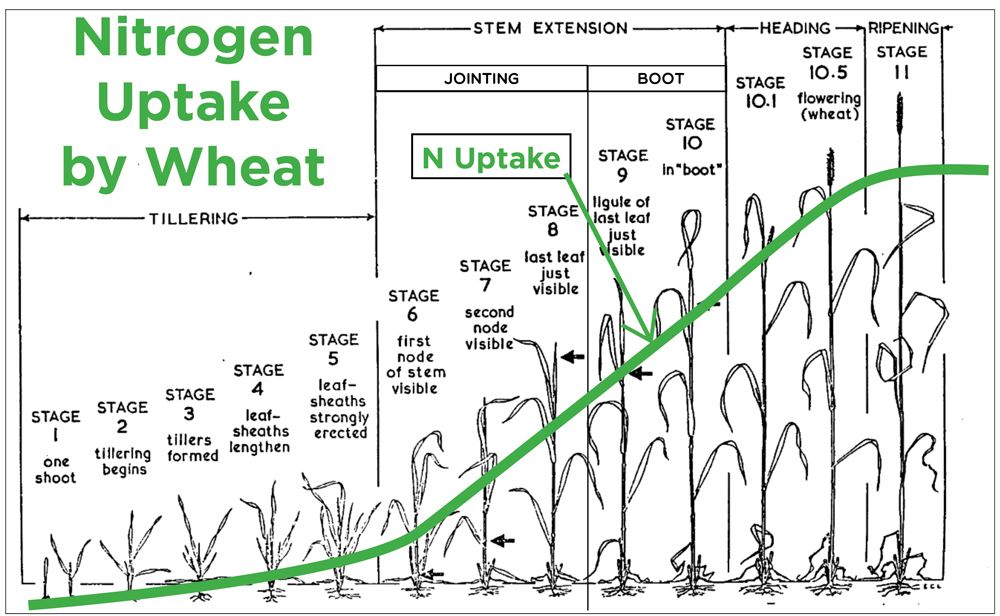Brought to you by: Jonah T. Johnson, MS, CPAg, CCA - Sales Agronomist, PCT | Sunrise
March 16, 2020: Winter wheat is greening up…Nitrogen and herbicide applications are nearing soon! Check out our spring nitrogen management and weed control tips.
Spring Nitrogen Management & Weed Control for Wheat
The warm temperatures in February had many growers contemplating an early N application to their wheat crops. Even with the recent cool down wheat development is still ahead of schedule. Nitrogen applied around the time of green-up can stimulate tillering, which is important if stands are thin. If stand counts look good (24-28 plant/sq. ft) and have good tillering which most wheat fields have then waiting to apply spring N just before jointing is advised. Applying N to good stands too early this year could promote too much growth, earlier jointing and make them more prone to freeze injury. Wheat begins to take N up rapidly after jointing, similar to the way corn begins to take up N rapidly after V7/8; so final applications of N should be complete by jointing. Only consider a split application if more than 120 lbs. of N/ac are being applied.
The warm temperatures in February had many growers contemplating an early N application to their wheat crops. Even with the recent cool down wheat development is still ahead of schedule. Nitrogen applied around the time of green-up can stimulate tillering, which is important if stands are thin. If stand counts look good (24-28 plant/sq. ft) and have good tillering which most wheat fields have then waiting to apply spring N just before jointing is advised. Applying N to good stands too early this year could promote too much growth, earlier jointing and make them more prone to freeze injury. Wheat begins to take N up rapidly after jointing, similar to the way corn begins to take up N rapidly after V7/8; so final applications of N should be complete by jointing. Only consider a split application if more than 120 lbs. of N/ac are being applied.

Spring Herbicide Applications on Winter Wheat-Purdue University
https://extension.entm.purdue.edu/newsletters/pestandcrop/article/spring-herbicide-applications-on-winter-wheat/
The winter is finally winding down and we are bound to have warmer days and spring in the near future. As we look towards the warmer weather there a few field activities that are going to start quickly, including winter wheat green-up herbicide applications and winter annual weed burndown applications in no-till fields. There are few things to keep in mind as these activities are added to the calendar. Many wheat producers, especially in the southern regions of Indiana will soon be or already are topdressing their wheat. Those looking into topdressing need to also be scouting for weeds and determining if an herbicide application is necessary on any existing winter annual weeds. The following information will outline winter annual weeds to look out for, weed scouting tips, crop stage restrictions, and herbicide recommendations.
Some common broadleaf weeds to scout for in your winter wheat are dandelion, purple deadnettle, henbit, chickweed, Canada thistle, and wild garlic. These winter annual species that emerge in the fall can remain relatively inconspicuous through the winter and become competitive and troublesome during the spring if not controlled early in the spring. Summer annual weeds such as ragweed will be of less concern in the early spring and will be outcompeted by the wheat crop if managed properly. Grass weeds to be aware of and scouting for are annual bluegrass, annual ryegrass, cheat, and downy brome.
Determining the severity of weed infestations in your wheat fields is key in determining the necessity of an herbicide application. As with all agronomic crops, you should scout your entire field to determine what weed management practices need to be implemented and determine any areas of severe weed infestations. Wheat fields that contain uniform infestations of at least one broadleaf weed and/or three grass weeds per square foot should be taken into consideration for an herbicide application to avoid yield loss and harvest interference problems. Some fields that have fewer uniform infestations, but rather pockets of severe infestation should be managed to reduce weed seed production and future infestations.
When determining your herbicide program for spring applications, the stage of the wheat crop should be considered. The majority of wheat herbicides are labeled for application at certain wheat growth stages and some commonly used herbicides have very short windows in which they can be applied. The popular broadleaf weed herbicides 2,4-D and MCPA are efficient and economical but can only be applied for a short period of time between tillering and prior to jointing in the early spring. Wheat growth stages and herbicide timing restriction are outlined in Figure 1.
If weed infestations are severe enough to require an herbicide application, the use of liquid nitrogen fertilizer solution as a carrier is a popular option for applying herbicides and topdressing the wheat crop in a single pass over the field. Caution should be taken when using a liquid fertilizer as an herbicide carrier as moderate to severe crop injury can result, especially in saturated conditions. Many post applied wheat herbicide labels allow for liquid nitrogen carriers but require different rates and types of surfactants than if the herbicide was applied with water as the carrier. Table 1 includes precautions to be taken when applying wheat herbicides using liquid fertilizer as a carrier; further details and directions can be acquired from the herbicide label.
Another consideration growers should take into account when planning early spring herbicide applications is the plant back restrictions to double crop soybeans. A large percentage of the herbicides listed in Table 1, especially those with activity on Ryegrass and Brome, have soybean plant back restrictions greater than the typical three-month time period between spring applications and double crop soybean planting. The soybean plant back restrictions greatly reduce the number of options available to wheat producers who double crop soybeans after wheat. Refer to Table 1 for more specific plant back timing restrictions.
